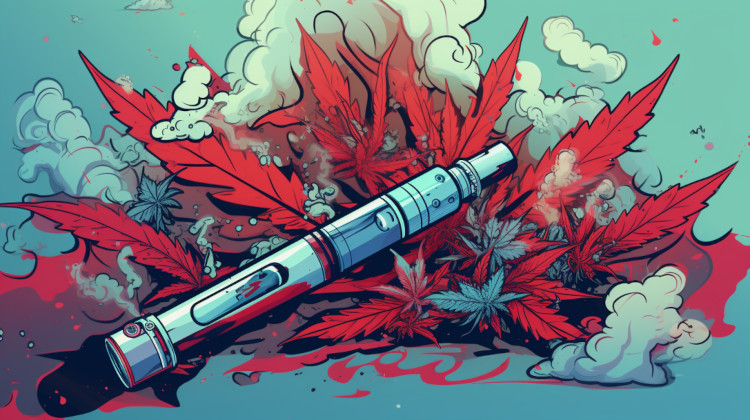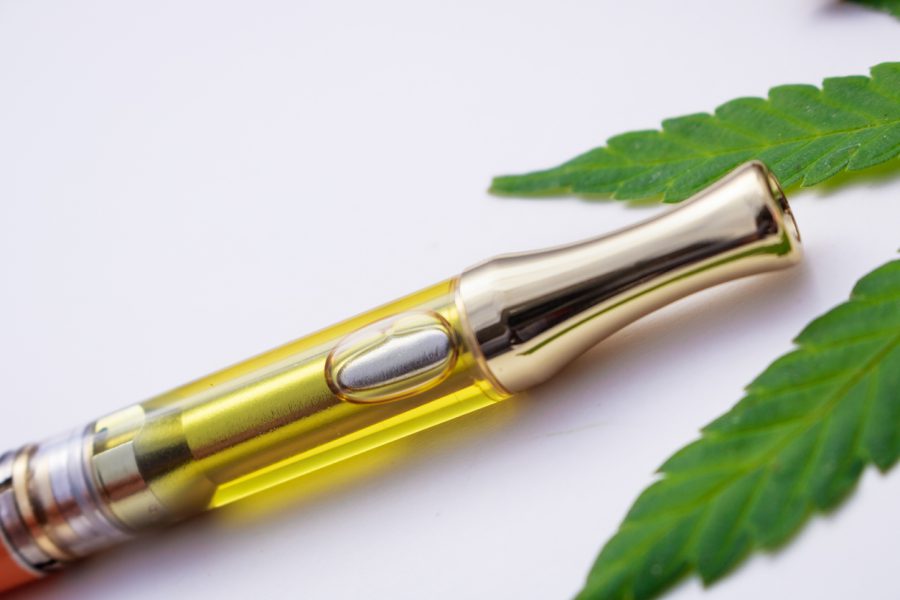CBD, which derives from both high-THC cannabis and hemp, continues to gain popularity for its potential therapeutic benefits. Research shows the compound may offer relief from symptoms of chronic pain, anxiety, and more for some consumers.1
Vaping CBD has become a popular option thanks to its fast absorption into the bloodstream and customizable serving sizes. It’s a simple, easily accessible way to experience CBD’s possible benefits.
And while there are a plethora of other CBD products available, maybe vaping especially interests you. Fortunately, the consumption method isn’t complicated, and it doesn’t have to be daunting – no matter your experience level.
This guide explores everything about vaping CBD so you can understand the benefits, risk factors, and more about the process.
What is CBD?
Cannabinoids are natural chemical compounds in the cannabis plant. CBD, short for cannabidiol, is one of the most prevalent naturally occurring cannabinoids in the cannabis plant. Unlike its cousin, THC, CBD doesn’t get you high, as it’s non-intoxicating. However, it does potentially provide several therapeutic properties.
The cannabinoid interacts with the body's endocannabinoid system (ECS), which is crucial in maintaining balance and regulating various physiological processes.2
CBD’s popularity primarily stems from its potential to offer several therapeutic benefits. Many consumers enjoy its ability to provide pain management, anxiety relief, and more – without the mind-altering effects associated with THC. Its versatility and non-intoxicating nature often make it a sought-after natural remedy for a variety of symptoms.
Another reason for CBD’s popularity is its legality across the nation. The 2018 Farm Bill legalized hemp and redefined it as any cannabis strain containing 0.3% delta-9 THC or less.
With no limits on CBD quantity, CBD products quickly began flooding the market. CBD products come in traditional cannabis variations like dry flower, pre-rolled joints, edibles, tinctures, topicals, concentrates, and vape pens.
Vape pens have become increasingly popular for their ability to deliver potent effects with few inhales.
How Does Vaping Work?

Vaping involves the use of a battery-operated vaporizer or vape pen to heat a liquid or concentrate. In some cases, a dry herb vape can heat flower instead. By heating it to a precise temperature, the vape turns the extract or flower into a fine mist that can be inhaled.3
What you vape can vary widely. E-cigarettes typically contain nicotine, but many consumers use vapes to inhale other substances. Weed carts are popular nowadays, as are CBD vape products. They’re convenient, discreet, impressively portable, and typically potent – certainly a powerful combination for cannabis consumers.
Compared to traditional smoking, vaping has some key differences:
- Combustion through smoking means inhaling burning cannabis smoke.
- Vaping instead produces vapor when heated, which doesn’t produce the same harmful byproducts of combustion. It may be less harmful than smoking, as it reduces exposure to toxins, carbon monoxide, and chronic respiratory symptoms.4
Can You Vape CBD Oil?
Which extracts are compatible with CBD vaping? Not all CBD oils are suitable for it. You can vape CBD oil, but it must be formulated for vaporizers. Choose one designed specifically for inhalation. Other cannabidiol oils, like tinctures, may not be safe for the same purpose.
CBD Vape: Reported Benefits
Studies have shown that CBD may potentially provide a wide range of benefits, and there are several additional advantages to specifically CBD vaping.
Anti-Inflammatory
Numerous clinical studies observed CBD’s therapeutic benefits, which include its anti-inflammatory properties.5 It may be effective for consumers with arthritis or other inflammatory conditions. To tie in with its anti-inflammatory effects, CBD may also exhibit sebum-reducing and sebum-regulating properties.6 This combination may make it a powerful option for managing acne.
Analgesic
Research also consistently observes CBD’s pain-relieving properties.7 While it’s not a cure-all for pain, research suggests that it is possible to find relief from certain types of chronic pain.
Anticonvulsant
The FDA’s approval of Epidiolex cements CBD’s potential efficacy in lessening and preventing seizures, as it has demonstrated antiepileptic properties, treating rare forms of epilepsy, including Dravet syndrome and Lennox-Gastaut syndrome.
Anxiolytic
Many know CBD as a relaxing, anxiety-reducing cannabis compound. It may help reduce symptoms of anxiety, including sweating and rapid heartbeat.7
Antidepressant
For patients of all levels in symptom severity, CBD may have a positive impact on symptoms of depression, too.7
Sleep Aid
Some people find CBD helps improve sleep quality and manage symptoms of insomnia. Taking CBD in the evening has a profound effect on some people’s sleep.
Overall Well-Being
Further research suggests CBD may have a beneficial impact on the overall well-being of people with moderate to severe symptoms.7
CBD When Using a Vape
What does CBD do for you in a vape that’s so special, though? As previously mentioned, vaping is less harmful than traditional smoking. It lessens the risk of chronic respiratory symptoms by preventing the inhalation of toxins, carbon monoxide, and more.
Vapes are typically more potent than smoking and take effect more quickly than edibles, giving it a sweet spot for preference.
CBD Vape Side Effects and Risks

As with all substances, vaping CBD oil comes with its own potential side effects and risks. Fortunately, CBD’s common side effects are mild.
Medication Interactions
First, CBD may interact with certain medications, potentially impacting their efficacy. If you’re taking other prescription medications, speak with a medical health professional before incorporating CBD into your daily routine.
Potential Side Effects
CBD is non-intoxicating, but high doses may still lead to a sedative-like property. You may feel drowsiness or a change in mood. It’s always best to start with a smaller serving size to prevent unwanted side effects.
Other common side effects of CBD include low blood pressure, dry mouth, and even light-headedness.8 Moderation is key to preventing side effects from occurring.
In addition, CBD may affect appetite, but the effect varies by person. It could stimulate appetite or decrease hunger.
Product Quality
One important note is that the CBD market is still heavily underregulated. That increases the risk of purchasing low-quality, mislabeled, and unsafe products. Ensure product quality and purity by purchasing through licensed dispensaries and trustworthy brands.
Start with a low dose and gradually increase as needed. That helps mitigate risks and ensure a safe, effective CBD vaping experience.
Potential Risks of Vaping
While, in a lot of ways, vaping is safer than smoking, that doesn't mean that vaping CBD oil is completely risk-free. There are still concerns that you need to be aware of before you start vaping CBD.
Counterfeit Vapes
Counterfeit and substandard vape products pose a significant risk to consumers. These products may contain harmful additives, such as synthetic cannabinoids or toxic chemicals, which pose serious health risks. It’s crucial to ensure the authenticity of your vape products and learn how to spot fake weed carts.
Lung Health
Vaping, whether it involves CBD or other substances, can present potential risks to lung health. Inhaling vapor from low-quality or highly processed vape products may lead to respiratory issues. There’s also a lack of evidence comparing the long-term effects on lung health of smoked versus vaporized cannabis.9
Vaping vs. Other Consumption Methods

There are a variety of methods available to consume CBD, each offering its own unique advantages and considerations. Vaping stands out as a popular choice with its rapid onset of effects and potential harm reduction compared to smoking.
But how does vaping compare to other primary consumption methods? You can compare the methods by delivery, the risk factors of each, and their bioavailability.
Smoking vs. Vaping
Delivery: Smoking involves inhaling cannabis through combustion, which produces smoke. Comparatively, you inhale vapor through a vaporizer or vape pen when vaping.
Risk Factors: Smoking may expose you to harmful toxins, including carcinogens and other combustion byproducts. That poses risks to your lung health, including developing respiratory issues.
By contrast, vaping may reduce exposure to toxins and other contaminants, thereby reducing overall harm.8
Bioavailability: Overall, vaping appears to deliver more potent effects than smoking, likely due to the higher levels of cannabinoids in vaping products compared to flower. Regardless, bioavailability for both is high, ranging from 10% to 35% due to the rapid absorption through the lungs.10
Edibles vs. Vaping
Delivery: Edibles involve ingesting substances like CBD through food or beverages. They are then metabolized in the liver, creating another active metabolite, 7-OH-CBD.10 Meanwhile, vaping simply involves inhaling the substance through a vape pen or vaporizer, bypassing the liver.
As a result, the onset of effects of vaping CBD vs eating CBD edibles differs, sometimes drastically. You can feel the effects of vaping almost immediately.
On the other hand, edibles may not kick in for up to two hours. The delay is due to the digestive process edibles undergo. The downside is that it can make it challenging to titrate serving sizes accurately.
Risk Factors: Not being able to titrate accurately may lead to accidental overconsumption. Frequently, users may eat more edibles, thinking the initial dose needs to be increased. It’s easier to monitor a vape product’s potency because the effects are typically noticeable within a few minutes.
Bioavailability: Edibles usually have lower bioavailability (as low as 6%) due to first-pass metabolism in the liver.10 It’s another reason for the delayed effect, which can also feel less potent than vaping.
Oils/Tinctures vs. Vaping
Delivery: Oils, tinctures, and liquid cannabis extracts can be administered sublingually, which is under the tongue. That allows for the fastest absorption as it goes through the mouth’s mucous membranes. Alternatively, you can mix the oils with food or beverages.
These extracts have a predictable kind of onset similar to vaping. Therefore, there’s a lower risk of overconsumption compared to some other methods. And while the duration of effects can vary, a tincture’s effects may last for several hours.
Risk Factors: Compared to other methods, oils and tinctures are a safe, controlled option. They’re less likely to lead to overconsumption, so they may be in line with the same risk factors for vaping CBD.
Bioavailability: Sublingual administration provides a similar bioavailability to edibles and is generally lower than inhalation.10
Choosing the Right CBD Vape
Stay well-informed to ensure you make a safe, satisfying CBD vape choice. Vaping CBD oil can be a rewarding, effective, and enjoyable experience with the right high-quality product. There are several key factors to observe from any CBD brand you’re considering.
Lab Testing
Products should always be batch-tested by an independent, third-party, and reputable lab. Lab-tested CBD vapes provide the most transparency about their cannabinoid content.
Thorough labs also test for pesticides, fertilizers, heavy metals, and other contaminants to ensure safety as much as accuracy.
Product Specifications
Product labels need to specify, in detail, exactly what’s in that container. That includes (at minimum) cannabinoid content, THC and/or CBD percentages, concentration, and weight.
These key details help cement the validity of the product and help you understand the product’s potency. From there, you can better feel out how it may affect you.
Reputability
Stick with recognized brands that are known to adhere to quality standards, which is crucial for product effectiveness and safety. Opt for well-established, reputable brands in the CBD industry.
Cartridge Compatibility
Some consumers prefer cartridge-based vaporizers over disposables, which means always ensuring the cartridge is compatible. Different brands and models may have specific requirements for cartridges.
Avoiding Counterfeit Cartridges
Until proper market regulation occurs, there will always be counterfeit and underregulated CBD products.11 Be cautious when making any vape CBD purchase, as counterfeits can pose significant health risks, including exposure to harmful contaminants.
Opt for regulated products with quality control measures, contamination mitigation, independent lab testing, and concentration testing. Understanding these key aspects that go into a quality CBD product will help you vape CBD more easily.
How to Vape CBD: A General Overview

So, you’re ready to vape CBD, but you’re unsure how to get started. CBD vaping isn’t too different from vaping any other type of cannabis extract.
Choose a Battery or Pen
First, decide if you want to purchase cartridges or if you’d prefer disposable pens. There are pros and cons to each type of cannabis vape, so it all comes down to preference.
If you’re purchasing a cartridge, you’ll need a battery. The most common option is a 510 thread, also known as a “universal” battery, which will fit most cartridges. Some batteries have different temperature settings or added features. Once you’re finished consuming the cartridge, you can keep the battery, clean it, and use it for the next cartridge.
Some brands have proprietary options that only fit their cartridges. There are also "disposable" options that don’t require you to keep the battery and be disposed of once you’ve finished. If you’re vaping CBD flower, this will require a different device, like the Pax Plus, designed to heat flower and concentrates.
What you choose is a matter of personal preference.
Pick Your Product
Think about the effect you’re after, including the level of intoxication you wish to feel. Most vape CBD products have different ratios of CBD to THC. Federally legal CBD products will contain 0.3% delta-9 THC or less, while CBD-dominant products in legal cannabis dispensaries may have more THC.
If you’re after potency with little to no intoxication, high CBD products may be a good option. A 30:1 ratio might be a step up from that if you’re in a medical/recreational state with access. Some consumers find more effective relief but a more intoxicating experience at a 1:1 or 3:1 ratio.
Load the Pen
Follow the instructions for your specific device. Twist the cart onto the battery or load the flower into the correct chamber.
Inhale
Depending on your device, you may have to click a button to heat and/or while inhaling. If you’re new to cannabis consumption, take one or two hits, then wait 5-10 minutes to see how you feel. You should feel the effects within this time.
Continue using your vape the same way until you’re comfortable or reach your desired feeling.
References
- Meissner H, Cascella M. Cannabidiol (CBD). In: StatPearls [Internet]. StatPearls Publishing; 2023. https://www.ncbi.nlm.nih.gov/books/NBK556048
↩︎ - Sheikh NK, Dua A. Cannabinoids. In: StatPearls [Internet]. StatPearls Publishing; 2023. https://www.ncbi.nlm.nih.gov/books/NBK556062/
↩︎ - NIDA. Vaping Devices (Electronic Cigarettes) DrugFacts. National Institute on Drug Abuse website. https://nida.nih.gov/publications/drugfacts/vaping-devices-electronic-cigarettes. January 8, 2020 Accessed November 6, 2023.
↩︎ - Chaiton M, Kundu A, Rueda S, Di Ciano P. Are vaporizers a lower-risk alternative to smoking cannabis?. Can J Public Health. 2022;113(2):293-296. doi:10.17269/s41997-021-00565-w
↩︎ - Morales P, Reggio PH. CBD: A New Hope? ACS Medicinal Chemistry Letters. 2019;10(5):694-695. doi:https://doi.org/10.1021/acsmedchemlett.9b00127
↩︎ - Oláh A, Tóth BI, Borbíró I, et al. Cannabidiol exerts sebostatic and antiinflammatory effects on human sebocytes. J Clin Invest. 2014;124(9):3713-3724. doi:10.1172/JCI64628
↩︎ - Rapin L, Gamaoun R, El Hage C, Arboleda MF, Prosk E. Cannabidiol use and effectiveness: real-world evidence from a Canadian medical cannabis clinic. J Cannabis Res. 2021;3(1):19. Published 2021 Jun 23. doi:10.1186/s42238-021-00078-w
↩︎ - Huestis MA, Solimini R, Pichini S, Pacifici R, Carlier J, Busardò FP. Cannabidiol Adverse Effects and Toxicity. Current Neuropharmacology. 2019;17(10):974-989. doi:https://doi.org/10.2174/1570159X17666190603171901
↩︎ - Chadi N, Minato C, Stanwick R. Cannabis vaping: Understanding the health risks of a rapidly emerging trend. Paediatr Child Health. 2020;25(Suppl 1):S16-S20. doi:10.1093/pch/pxaa016
↩︎ - Lucas CJ, Galettis P, Schneider J. The pharmacokinetics and the pharmacodynamics of cannabinoids. British Journal of Clinical Pharmacology. 2018;84(11):2477-2482. doi:https://doi.org/10.1111/bcp.13710
↩︎ - MacCallum CA, Lo LA, Pistawka CA, Boivin M. A Clinical Framework for Evaluating Cannabis Product Quality and Safety. Cannabis and Cannabinoid Research. 2022;8(3). doi:https://doi.org/10.1089/can.2021.0137
↩︎
The information in this article and any included images or charts are for educational purposes only. This information is neither a substitute for, nor does it replace, professional legal advice or medical advice, diagnosis, or treatment. If you have any concerns or questions about laws, regulations, or your health, you should always consult with an attorney, physician or other licensed professional.




